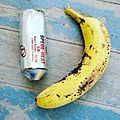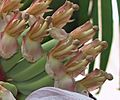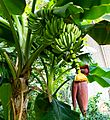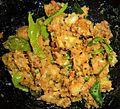Banana facts for kids
Quick facts for kids Banana |
|
|---|---|
 |
|
| Peeled, whole, and cross section | |
| Scientific classification | |
| Kingdom: | |
| (unranked): | |
| (unranked): | |
| (unranked): | |
| Order: | |
| Family: | |
| Genus: | |
A banana is a super popular fruit that grows on large herbaceous plants. These plants belong to a group called Musa. Bananas originally came from the tropical areas of southeast Asia.
Many people believe that bananas were first grown for food in Papua New Guinea. Today, you can find them growing in tropical regions all over the world. Most banana plants are grown for their delicious fruits. These fruits are actually a type of berry in the plant world! Some banana plants are also grown just for their beauty as ornamental plants, or for their strong fibres.
There are about 110 different kinds of bananas. When most people talk about "bananas," they usually mean the soft, sweet kind. These are often called dessert bananas. Other types, known as cultivars (different varieties), have a firmer, starchier fruit. These are usually called plantains. Plantains are mostly used for cooking or for their fibres.
Besides being a tasty snack, bananas have other cool uses! In Africa, people make beer by fermenting the juice of certain banana types. These are known as beer bananas. The ash left over from burning banana plants can even be used to make soap. In Asia, banana plants are often planted to give shade to other plants that love the shade. This includes plants like coffee, cocoa, nutmeg, or black pepper. That's why you might often see banana plants growing on farms with other crops.
Contents
Discover the Banana Plant
The banana plant is actually the biggest herbaceous flowering plant on Earth. People often mistake them for trees, but they're not! Banana plants have a false stem (called a pseudostem). This is made up of the lower parts of their leaves wrapped tightly together. This pseudostem can grow super tall, from two to eight meters (about 6 to 26 feet) high!
Each pseudostem grows from a thick underground stem called a corm. A single pseudostem can produce one big bunch of bananas. After it fruits, that pseudostem dies. Then, a new one grows to take its place. When most bananas are ripe, they turn yellow or sometimes even red. Unripe bananas are usually green.
Banana leaves grow in a spiral pattern. They can be really big, up to 2.7 meters (about 9 feet) long and 60 centimeters (about 2 feet) wide. They tear easily in the wind. This gives them that familiar, frayed look you often see.
Exploring the Banana Fruit
Banana fruits grow from a banana blossom in hanging clusters. These are often called a bunch or banana stem. The fruits grow in rows, which are called tiers or hands. There can be as many as twenty fruits in one "hand." There can be up to twenty "tiers" in a whole bunch! A full bunch of bananas usually weighs between 30 and 50 kilograms (65 to 110 pounds).
A single banana (also called a finger) weighs about 125 grams (4.4 ounces) on average. About three-quarters of that weight is water.
Each banana has a protective outer layer called the peel or skin. Inside, there's a fleshy part that easily splits into three sections. It's the only known fruit in the world that naturally splits into three segments! Both the skin and the inside part can be eaten. In Western cultures, people usually eat the inside raw and throw away the skin. However, some Asian cultures cook and eat both the skin and the inside. Each fruit also has many thin "strings" that run between the skin and the inner part.
Bananas are packed with good stuff! They have a lot of vitamin B6, vitamin C, and potassium.
What are the health benefits of bananas?
A medium-sized banana gives you around 320-400 mg of potassium. This meets about 10% of the potassium you need every day! Potassium is super important because it helps your body keep your heart healthy. It also helps keep your blood pressure normal. Plus, bananas are low in sodium. The combination of low sodium and high potassium is great for helping to control high blood pressure.
Growing and Trading Bananas Globally
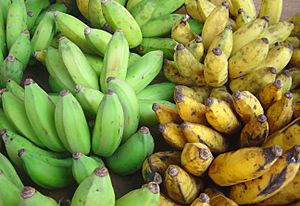
Bananas are grown in at least 107 countries around the world. Wild banana species have fruits with many hard, large seeds. However, almost all the bananas we eat are seedless fruits. Bananas are usually grouped as either dessert bananas (the sweet ones we snack on) or green cooking bananas (like plantains). Most bananas that are exported to other countries are the dessert types. Only about 10 to 15 percent of all bananas grown are for export. Dessert bananas change color and usually turn yellow when they are ripe. Plantains and cooking bananas often stay green. Some special bananas have other colors when ripe!
The countries that produce the most bananas include India, Brazil, China, Ecuador, and the Philippines. The top five countries that export bananas are Ecuador, Costa Rica, the Philippines, Colombia, and Guatemala. The United States, the European Union, and Japan buy the most bananas. Bananas are one of the most valuable agricultural products traded globally. For example, they made up about 60 percent of the export earnings for Saint Lucia between 1994 and 1996.
Understanding Banana Allergies
Some people can be allergic to bananas. There are two main types of these allergies. The first is called oral allergy syndrome. If someone has this, they might experience swelling inside their mouth or throat within an hour of eating a banana. This type of allergy is often linked to allergies caused by pollen, like from a birch tree. The second type of banana allergy is similar to latex allergies. It can cause urticaria (hives) and potentially serious stomach problems.
Other Amazing Uses for Bananas
Banana Fibers for Textiles
The strong fibre from the banana plant has been used to make textiles for a very long time. In Japan, bananas have been grown to make clothing and household items since at least the 13th century. In the traditional Japanese method, the leaves and shoots are cut from the plant regularly. This makes sure they stay soft. The harvested shoots are then boiled in lye to prepare the fibres for making yarn.
These banana shoots produce fibres that vary in softness. They can be used for different qualities of yarns and textiles. For example, the toughest outer fibres of the shoots are great for tablecloths. The softest inner fibres are perfect for delicate items like kimono and kamishimo. This traditional Japanese process for making banana cloth involves many steps, all done by hand.
Another method is used in Nepal. There, the trunk of the banana plant is harvested instead. Small pieces of the trunk are softened. The fibres are then taken out using machines, bleached, and dried. These fibres are then sent to the Kathmandu Valley. There, beautiful, high-end rugs are made. These rugs feel and look a lot like silk. These banana fibre rugs are created using traditional Nepalese hand-knotting methods.
Banana Paper Production
Banana fibre is also used to make banana paper. There are two different kinds of banana paper. One is paper made from the bark of the plant. The other is paper made from the fibre and from unused banana fruits.
See also
Images for kids
-
Cavendish bananas are the most common dessert bananas sold.
-
Original native ranges of the ancestors of modern edible bananas. Musa acuminata is shown in green and Musa balbisiana in orange.
-
Fruits of wild-type bananas have numerous large, hard seeds.
-
Chronological dispersal of Austronesian peoples across the Indo-Pacific
-
Cavendish bananas are the main commercial banana cultivars sold in the world market.
-
Banana bunches are sometimes encased in plastic bags for protection. The bags may be coated with pesticides.
-
A tear gas canister with a banana for scale. This method of size comparisons is an internet meme.
-
Banana 'tree' showing fruit and inflorescence
-
Kilawin na pusô ng saging, a Filipino dish using banana flowers
-
Nicaraguan Nacatamales, in banana leaves, ready to be steamed
-
Kaeng yuak is a northern Thai curry made with the core of the banana plant.
-
Pisang goreng fried banana coated in batter, popular snack in Indonesia
See also
 In Spanish: Banana para niños
In Spanish: Banana para niños




















